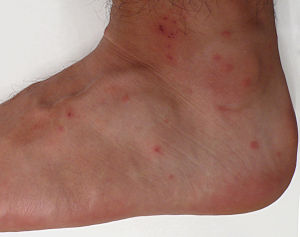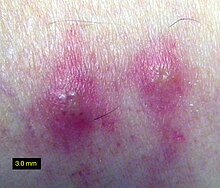
Scabies is a contagious skin infestation by the mite Sarcoptes scabiei. The most common symptoms are severe itchiness and a pimple-like rash. Occasionally, tiny burrows may appear on the skin. In a first-ever infection, the infected person usually develops symptoms within two to six weeks. During a second infection, symptoms may begin within 24 hours. These symptoms can be present across most of the body or just certain areas such as the wrists, between fingers, or along the waistline. The head may be affected, but this is typically only in young children. The itch is often worse at night. Scratching may cause skin breakdown and an additional bacterial infection in the skin.
An allergen is a type of antigen that produces an abnormally vigorous immune response in which the immune system fights off a perceived threat that would otherwise be harmless to the body. Such reactions are called allergies.

Mites are small arachnids. Mites span two large orders of arachnids, the Acariformes and the Parasitiformes, which were historically grouped together in the subclass Acari. However, most recent genetic analyses do not recover the two as each other's closest relative within Arachnida, rendering the group non-monophyletic. Most mites are tiny, less than 1 mm (0.04 in) in length, and have a simple, unsegmented body plan. The small size of most species makes them easily overlooked; some species live in water, many live in soil as decomposers, others live on plants, sometimes creating galls, while others again are predators or parasites. This last type includes the commercially destructive Varroa parasite of honey bees, as well as scabies mites of humans. Most species are harmless to humans, but a few are associated with allergies or may transmit diseases.

Colorado tick fever (CTF) is a viral infection (Coltivirus) transmitted from the bite of an infected Rocky Mountain wood tick (Dermacentor andersoni). It should not be confused with the bacterial tick-borne infection, Rocky Mountain spotted fever. Colorado tick fever is probably the same disease that American pioneers referred to as "mountain fever".

Blepharitis, sometimes known as "granulated eyelids," is one of the most common ocular conditions characterized by inflammation, scaling, reddening, and crusting of the eyelid. This condition may also cause swelling, burning, itching, or a grainy sensation when introducing foreign objects or substances to the eye. Although blepharitis by itself is not sight-threatening, it can lead to permanent alterations of the eyelid margin. The primary cause is bacteria and inflammation from congested meibomian oil glands at the base of each eyelash. Other conditions may give rise to blepharitis, whether they be infectious or noninfectious, including, but not limited to, bacterial infections or allergies.

Allergic conjunctivitis (AC) is inflammation of the conjunctiva due to allergy. Although allergens differ among patients, the most common cause is hay fever. Symptoms consist of redness, edema (swelling) of the conjunctiva, itching, and increased lacrimation. If this is combined with rhinitis, the condition is termed allergic rhinoconjunctivitis (ARC).

Sandfly or sand fly is a colloquial name for any species or genus of flying, biting, blood-sucking dipteran (fly) encountered in sandy areas. In the United States, sandfly may refer to certain horse flies that are also known as "greenheads", or to members of the family Ceratopogonidae. The bites usually result in a small, intensely itchy bump or welt, the strength of which intensifies over a period of 5-7 days before dissipating. Moderate relief is achieved with varying success through the application of over the counter products such as Benadryl (ingested) or an analgesic cream such as After Bite. Outside the United States, sandfly may refer to members of the subfamily Phlebotominae within the Psychodidae. Biting midges (Ceratopogonidae) are sometimes called sandflies or no-see-ums. New Zealand sandflies are in the genus of sand fly Austrosimulium, a type of black fly.

Varroa destructor, the Varroa mite is an external parasitic mite that attacks and feeds on the honey bees Apis mellifera and Apis cerana. The disease caused by the mite in this genus is called varroosis.
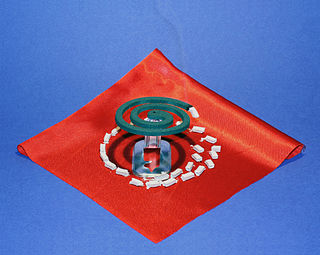
An insect repellent is a substance applied to the skin, clothing, or other surfaces to discourage insects from landing or climbing on that surface. Insect repellents help prevent and control the outbreak of insect-borne diseases such as malaria, Lyme disease, dengue fever, bubonic plague, river blindness, and West Nile fever. Pest animals commonly serving as vectors for disease include insects such as flea, fly, and mosquito; and ticks (arachnids).

Trombicula, known as chiggers, red bugs, scrub-itch mites, or berry bugs, are small arachnids in the Trombiculidae family. In their larval stage, they attach to various animals, including humans, and feed on skin, often causing itching and trombiculosis. These relatives of ticks are nearly microscopic, measuring 0.4 mm (0.01 in) and have a chrome-orange hue. A common species of harvest mite in North America is Trombicula alfreddugesi.
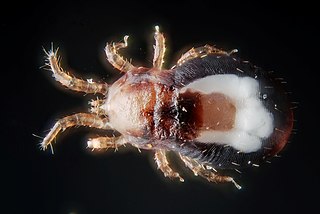
Dermanyssus gallinae is a haematophagous ectoparasite of poultry. It has been implicated as a vector of several major pathogenic diseases. Despite its common names, it has a wide range of hosts including several species of wild birds and mammals, including humans. In both size and appearance, it resembles the northern fowl mite, Ornithonyssus sylviarum.

Pyemotes herfsi, also known as the oak leaf gall mite or itch mite, is an ectoparasitic mite identified in Western Canada in 1923 and subsequently found in India, Asia, and the United States. The mite parasitizes a variety of insect hosts and bites humans, causing red, itchy, and painful wheals (welts). The mites are barely visible, measuring about 0.2–0.8 millimeters; their great reproductive potential, small size, and high capacity for dispersal by wind make them difficult to control or avoid.

Trombiculidae ; commonly referred to in North America as chiggers and in Britain as harvest mites, but also known as berry bugs, bush-mites, red bugs or scrub-itch mites, are a family of mites. Chiggers are often confused with jiggers – a type of flea. Several species of Trombiculidae in their larva stage bite their animal or human host and by embedding their mouthparts into the skin cause "intense irritation" or "a wheal, usually with severe itching and dermatitis".
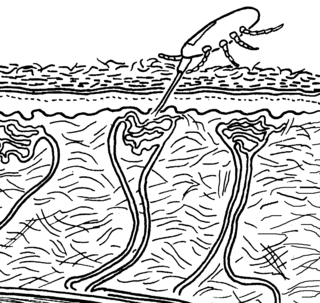
Gamasoidosis, or dermanyssosis, is a frequently unrecognized ectoparasitosis and source of growing concern in human medicine, occurring after contact with avian mites which infest canaries, sparrows, starlings, pigeons and poultry and caused by two genera of mites, Ornithonyssus and Dermanyssus. Avian mite species implicated include the red mite, tropical fowl mite and northern fowl mite . Mite dermatitis is also associated with rodents infested with the tropical rat mite, spiny rat mite and house-mouse mite, where the condition is known as rodent mite dermatitis. Urban gamasoidosis is associated with window-sills, ventilation and air-conditioning intakes, roofs and eaves, which serve as shelters for nesting birds. Humans bitten by these mites experience a non-specific dermatitis with intense itching.
Queensland tick typhus is a zoonotic disease caused by the bacterium Rickettsia australis. It is transmitted by the ticks Ixodes holocyclus and Ixodes tasmani.

Mites that infest and parasitize domestic animals cause disease and loss of production. Mites are small invertebrates, most of which are free living but some are parasitic. Mites are similar to ticks and both comprise the order Acari in the phylum Arthropoda. Mites are highly varied and their classification is complex; a simple grouping is used in this introductory article. Vernacular terms to describe diseases caused by mites include scab, mange, and scabies. Mites and ticks have substantially different biology from, and are classed separately from, insects. Mites of domestic animals cause important types of skin disease, and some mites infest other organs. Diagnosis of mite infestations can be difficult because of the small size of most mites, but understanding how mites are adapted to feed within the structure of the skin is useful.

Mites are small crawling animals related to ticks and spiders. Most mites are free-living and harmless. Other mites are parasitic, and those that infest livestock animals cause many diseases that are widespread, reduce production and profit for farmers, and are expensive to control.
Foot odor or bromodosis is a type of body odor that affects the feet of humans.
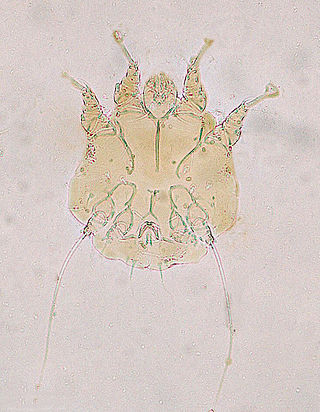
Notoedric mange, also referred to as Feline scabies, is a highly contagious skin infestation caused by an ectoparasitic and skin burrowing mite Notoedres cati. N. cati is primarily a parasite of felids, but it can also infest rodents, lagomorphs, and occasionally also dogs and foxes. This skin disease also has zoonotic potential. Infestation is also called acariasis, which refers to a rash that is caused by mites.

Dust mite allergy, also known as house dust allergy, is a sensitization and allergic reaction to the droppings of house dust mites. The allergy is common and can trigger allergic reactions such as asthma, eczema or itching. The mite's gut contains potent digestive enzymes that persist in their feces and are major inducers of allergic reactions such as wheezing. The mite's exoskeleton can also contribute to allergic reactions. Unlike scabies mites or skin follicle mites, house dust mites do not burrow under the skin and are not parasitic.
